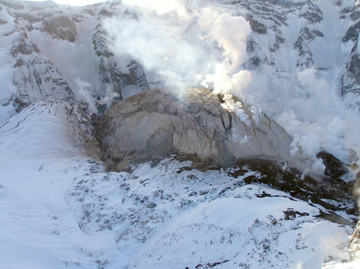
 “Something
extraordinary is happening in the crater at Mount St. Helens,” said Dan Dzurisin,
a geologist at the U.S. Geological Survey Cascades Volcano Observatory (CVO),
at a press conference at the annual meeting of the American Geophysical Union
in December in San Francisco. The eruption that began on Sept. 23 has shown no
signs of stopping. Instead, the volcano is erupting a dump-truck-load of fresh
hot rock every second of the day — that’s five cubic yards per second,
he said — in the form of an ever-growing lava dome. Thus far, the lava dome
has grown by as much as the size of the world’s largest aircraft carrier.
“Something
extraordinary is happening in the crater at Mount St. Helens,” said Dan Dzurisin,
a geologist at the U.S. Geological Survey Cascades Volcano Observatory (CVO),
at a press conference at the annual meeting of the American Geophysical Union
in December in San Francisco. The eruption that began on Sept. 23 has shown no
signs of stopping. Instead, the volcano is erupting a dump-truck-load of fresh
hot rock every second of the day — that’s five cubic yards per second,
he said — in the form of an ever-growing lava dome. Thus far, the lava dome
has grown by as much as the size of the world’s largest aircraft carrier. |
Geotimes Home | AGI Home | Information Services | Geoscience Education | Public Policy | Programs | Publications | Careers |